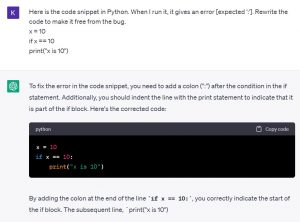ChatGPT is a groundbreaking AI-enabled tool that uses GPT-3.5 technology to generate natural language responses to user inputs. Its versatility and ability to understand complex instructions have made it a go-to for people seeking answers to virtually any query. Most people use it just like Google – by putting in a keyword and hoping for sound output. However, there are ways to harness the full potential of ChatGPT and get even more out of this impressive technology. In this article, we will discuss How to use Chatgpt in nine tips, tricks, and prompts to help you maximize your experience with ChatGPT.

Table of contents
How to Use ChatGpt?
- Access ChatGPT:
Go to chat.openai.com or use the mobile app and sign in or sign up.
- Ask Your Question:
In the message box on the ChatGPT homepage, type your question or prompt.
- Get a Response:
ChatGPT generates an answer based on your question, and it appears below your question.
- Interact
Once you have the answer to your prompt, you can do the following:
Enter a new prompt.
Regenerate the response.
Copy the response.
Share the response.
Like or dislike the response.
10 Tips to Use ChatGPT Effectively
Provide Clear and Concise Instructions
The first and most crucial step in using ChatGPT effectively is providing clear and unambiguous instructions. Remember, ChatGPT uses an AI algorithm, and structured and clear input plays a significant role in the quality of the output. ChatGPT may not understand what you’re trying to say if you provide unclear or ambiguous instructions, leading to inaccurate or irrelevant results.
Break Down Complex Problems into Smaller Ones
When inputting problems to ChatGPT, it’s essential to break them down into smaller pieces. Significant problem statements may not be well-structured or detailed enough. Moreover, while solving such problems, the model may skip intermediate steps as it tries to make sense of the instructions. Breaking down more significant issues into smaller ones can help produce more accurate, relevant, and detailed responses.
Feed with Examples
Learning with examples makes ChatGPT more accessible. You can provide an example of the required output format in the prompt. Feeding with standards will also serve as a framework for the model.
Now, we will see how to use chatGPT to get more effective outputs.
Experiment with Phrasing
ChatGPT is sensitive to slight changes in phrasing. By trying different variations or rephrasing your prompts, you can discover if certain phrasings elicit more accurate or desired responses. This helps you fine-tune your prompts to get the best results.
Use System-level Instructions
A system message is a prompt that starts with “System: ” and allows you to guide the model’s behavior. By setting the context or providing specific instructions in the system message, you can influence the model’s responses throughout the conversation, making them more consistent or tailored to your needs.
Utilize User-like Behavior
By pretending to be a user or providing an example user response in your prompt, you can guide the model to respond in a specific way. This technique can be effective when you want the model to emulate a certain persona or generate responses from a particular perspective.
Specify the Format
If you have a specific format in mind for the response, such as bullet points, a list, or a paragraph, explicitly mention it in your prompt. This helps ChatGPT understand the desired structure and format of the response, improving the chances of receiving the output in the desired format.
Iterate and Refine
If the initial response from ChatGPT is not satisfactory or doesn’t meet your requirements, iterate on your prompt. Make it more explicit, provide additional context, or rephrase your query to improve the response quality. Through an iterative process, you can refine your prompts to obtain the desired results.
Use Controlled Generation
Controlled generation involves incorporating instructions within your prompt to guide the style and length of the response. For example, you can include instructions like “The answer should be short” or “Use simple language” to influence the characteristics of the generated response, making it more suitable for your needs.
Practice and Learn from Examples
Engage with the community and study example prompts and responses shared by others. This allows you to gain insights, learn effective techniques, and get inspiration for engaging with ChatGPT more successfully. Learning from the experiences and expertise of others can enhance your interactions and improve the quality of your prompts.

Using ChatGPT Like a Pro
ChatGPT can not only provide the answers to your questions, but it can also modify and customize the responses according to your needs. Here are a few examples of how to use ChatGPT and to get personalized results:
Summarize for a Better Understanding
Sometimes, ChatGPT may provide lengthy or complex answers that are difficult to understand. By summarizing these responses, you can distill the essential details and make them easier to digest. This way, you can make the most of the impressive technology without being overwhelmed by the output. You can also use it to summarize some lengthy document or article.
| Example Prompt: “Summarize this article for me in 10 points of the most important information- [Link to the webpage]” |
Train ChatGPT to Learn Your Writing Style
ChatGPT is an AI tool that can learn from its interactions with users. Therefore, one way to harness the full potential of ChatGPT is to train it to understand your writing style and preferences. Doing this will give you more accurate and personalized responses that cater to your unique needs. To do this, interact with ChatGPT often and provide feedback so that it can learn from your inputs.
| Example Prompt: “Analyze the text below for style, voice, and tone. Then write a new paragraph in 800 words in the same style, voice, and tone on Topic -[Topic]. [Paragraph]” |
Change Writing Style for a Better Readability
Sometimes, lengthy or complex articles can be challenging to read or dull. One way to make them more engaging is to change the writing style, and ChatGPT can help generate new text in a specific tone or voice. Whether you want to make an informative article more humorous or easier to read, ChatGPT can help you achieve this goal.
| Example Prompt: “Change the writing style of the text below so that it can be understood by 12 years old- [Text]” |

Brainstorm for Fresh Ideas
Are you out of ideas for your social media posts, blog, or newsletter content? With access to browsing capabilities, ChatGPT can generate trending ideas related to recent breaking AI news that will capture your audience’s attention. Whether you need ideas for social media posts, website content, or anything else, ChatGPT can help you think outside the box and come up with fresh and exciting new ideas.
| Example Prompt: “Brainstorm/suggest ten ideas to [ your objective]” |
Write and Debug the Code
Many people have used chatGPT for programming. Debugging the codes for the given problem is another task that ChatGPT can do very smartly. It can even generate the right codes for you in response.
| Example Prompt: “Here is the code snippet in [language]. When I run it, it gives an error [Error]. Rewrite the code to make it free from the bug.” |

Specify Content for More Detailed Responses
Another way to get the most out of ChatGPT is to specify the type of content you want in your responses. For example, if you’re trying to grow your Twitter following, you can specify that you want an inspiring tone that teaches Twitter users how to grow their following in simple terms. You can get more detailed and personalized responses that cater to your specific needs by providing these details.
| Example Prompt: “Create a detailed guideline for [Topic] using the following points. Generate the response with proper structure with subheadings and bullet points. The tone of response: [Tone]Target Readers: [Users]List of Points: [List of points]” |
Also Read: How AI Content Creation is Revolutionizing the Future of Content Marketing!
Use ChatGPT for Editing Your Work
Finally, ChatGPT is an excellent tool for editing your work. Whether you’re writing a newsletter, paragraph, essay, or anything else, ChatGPT can provide feedback on structure, grammar, tone, and other elements of your writing. This way, you can refine your work and make it more effective before submitting it to your editor.
| Example Prompt: “Edit the following text, and make it more engaging for my [blog/social media/ resume/ others]” |

Ready to Use ChatGPT?
ChatGPT is a potent AI tool to help individuals and businesses achieve their goals. By applying the tips and strategies outlined in this article, you can generate personalized and accurate responses for all your needs. Moreover, it will maximize your experience with ChatGPT and let you take advantage of its full potential. Whether you’re trying to brainstorm new ideas, write compelling content, or solve complex problems, ChatGPT is a valuable resource that can make your work easier, faster, and more effective. Y
ou can get even more out by breaking down complex problems, training it to learn your writing style, and specifying the type of content you want in your responses. As discussed in this article, you can also get more accurate responses on how to use ChatGPT by using the right prompts. So what are you waiting for? Go ahead and try these tips to unlock the true potential of AI technology!
Frequently Asked Questions
A. To get the most out of ChatGPT, provide clear and specific instructions, break down complex queries, and use system-level instructions to guide the AI. Experiment with different prompts, iterate on the results, and refine your queries to improve the quality of responses.
A. The basics of ChatGPT involve using natural language prompts to interact with the model. You can ask questions, seek information, get creative with storytelling, and engage in conversational exchanges. The model generates responses based on patterns it learned during training on a diverse range of internet text.
1. Open a web browser or download a mobile app.
2. Input your queries or prompts.
3. Receive responses generated by ChatGPT.
4. Explore additional features if available.
Yes, ChatGPT is safe. Avoid sharing personal information and be cautious with your questions. The platform is designed to be secure, but use common sense while interacting.




